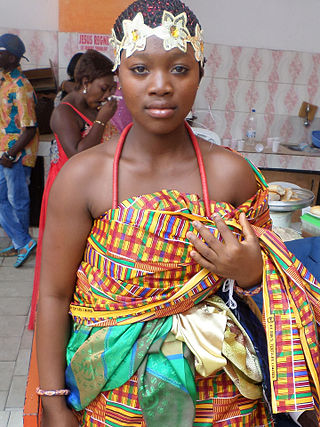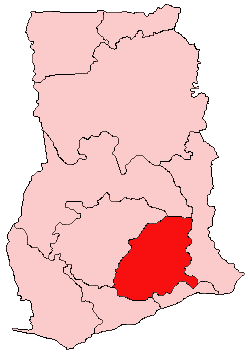Related Research Articles
Asante, also known as Ashanti, Ashante, or Asante Twi, is one of the principal members of the Akan dialect continuum. It is one of the three mutually intelligible dialects of Akan which are collectively known as Twi, the others being Bono and Akuapem. There are over 20 million speakers of the Asante language, mainly concentrated in Ghana and southeastern Cote D'Ivoire, and especially in and around the Ashanti Region of Ghana.
Akan is a group of several closely related languages within the wider Central Tano languages. These languages are the principal native languages of the Akan people of Ghana, spoken over much of the southern half of Ghana. About 80% of Ghana's population can speak an Akan language as a first or second language, and about 44% of Ghanaians are native speakers. There are populations of polyglots in Ghana who speak an Akan language as a third language. They are also spoken in parts of Côte d'Ivoire.
The Akan people of Ghana frequently name their children after the day of the week they were born and the order in which they were born. These "day names" have further meanings concerning the soul and character of the person. Middle names have considerably more variety and can refer to their birth order, twin status, or an ancestor's middle name.
Berekum is a city and is the capital of Berekum Municipal in the Bono Region of Ghana. Berekum has a population of 62,364. The native language of the Berekum people is the Bono Twi. As at 2020, the Omanhene of Berekum was Daasebre Dr. Amankona Diawuo II.

The Bono, also called the Brong and the Abron, are an Akan people of West Africa. Bonos are normally tagged Akan piesie or Akandifo of which Akan is a derivative name. Bono is the genesis and cradle of Akans. Bono is one of the largest ethnic group of Akan and are matrilineal people. Bono people speak the Bono Twi of Akan language. Twi language, thus the dialect of Bono is a derivative of a Bono King Nana Twi. In the late fifteenth century, the Bono people founded the Gyaaman kingdom as extension of Bono state in what is now Ghana and Côte d'Ivoire.

Kwahu is an area and group of people that live in Ghana and are part of the Twi-speaking Akan group. The region has been dubbed Asaase Aban, or the Natural Fortress, given its position as the highest habitable elevation in the country. Kwahu lies in the Eastern Region of Ghana, on the west shore of Lake Volta. The Kwahus share the Eastern Region with the Akyem and Akuapem, as well as the Adangbe-Krobos. Among Kwahu lands, a significant migrant population works as traders, farm-hands, fisherfolk, and caretakers in the fertile waterfront 'melting pot' of Afram plains. These migrants are mostly from the Northern and Volta Regions, as well as, some indigenous Guans from the bordering Oti and Brong-Ahafo regions live in the Afram Plains area. Kwahus are traditionally known to be wealthy traders, owning a significant number of businesses and industries in Ghana.

Adinkra are symbols from Ghana that represent concepts or aphorisms. Adinkra are used extensively in fabrics, logos and pottery. They are incorporated into walls and other architectural features. Adinkra symbols appear on some traditional Akan goldweights. The symbols are also carved on stools for domestic and ritual use. Tourism has led to new departures in the use of symbols in items such as T-shirts and jewellery.

Ghana is a multilingual country in which about eighty languages are spoken. Of these, English, which was inherited from the colonial era, is the official language and lingua franca. Of the languages indigenous to Ghana, Akan is the most widely spoken in the south. Dagbani is most widely spoken in the north.
Bono, also known as Abron, Brong, and Bono Twi, is a Central Tano language common to the Bono people and a major dialect of the Akan dialect continuum, and thus mutually intelligible with the principal Akan dialects of Asante and Akuapem, collectively known as Twi. It is spoken by 1.2 million in Ghana, primarily in the Central Ghanaian region of Brong-Ahafo, and by over 300,000 in eastern Ivory Coast.
Abusua is the name in Akan culture for a group of people that share common maternal ancestry governed by seven major ancient female abosom (deities). The Abusua line is considered to be passed through the mother's blood . There are several Abusua that transcend the different ethnic subgroups outside of the ancient seven. People of the same Abusua share a common ancestor somewhere within their bloodline, which may go back as far as thousands of years. It is a taboo to marry someone from the same Abusua. The different Abusua are the Agona (parrot), the Aduana (dog), the Asenie (bat), Oyoko (falcon/hawk), the Asakyiri (vulture), the Asona (crow), the Bretuo (leopard), and the Ekuona (bull).
In several Akan nations of Ghana, the Omanhene is the title of the supreme traditional ruler ('king') in a region or a larger town. The omanhene is the central figure and institution of the nation. Officially, he has no function in the current Ghanaian political setup, but, has enormous influence on the people that constitute it. Today 'Hene' can be found in titles of other rulers in Ghanaian nations. For example, the chief of the Dagomba in the north of Ghana is known as the 'Dagombahene'.

The Asante, also known as Ashanti, are part of the Akan ethnic group and are native to the Ashanti Region of modern-day Ghana. Asantes are the last group to emerge out of the various Akan civilisations. Twi is spoken by over nine million Asante people as a first or second language.
Oborɔnyi is the Akan word for foreigner, literally meaning "those who come from over the horizon." It is often colloquially translated into "white person."

Twi is a variety of the Akan language spoken in southern and central Ghana by several million people, mainly of the Akan people, the largest of the seventeen major ethnic groups in Ghana. Twi has about 4.4 million speakers.
Akuapem, also known as Akuapim, Akwapem Twi, and Akwapi, is one of the principal members of the Akan dialect continuum, along with Bono and Asante, with which it is collectively known as Twi, and Fante, with which it is mutually intelligible. There are 626,000 speakers of Akuapem, mainly concentrated in Ghana and southeastern Cote D'Ivoire. It is the historical literary and prestige dialect of Akan, having been chosen as the basis of the Akan translation of the Bible.
Juaben is a small town in the Ejisu-Juaben Municipal District, a district in the Ashanti Region of Ghana.
Asakyiri is one of the major eight major Akan clans. These clans are derived along the matrilineal lines.
Aduana is one of the seven major Akan clans of Ghana. It is also the largest clan in terms of population.
Asenie is one of the eight Akan major clans.

Oheneba is a regal rank given to both female or male child of a king or chief. It is the equivalent of prince or princess.
References
- ↑ "Ekuona". ASANTEMAN ASSOCIATION. Retrieved 2015-06-16.
- ↑ "twi.bb - Online Twi Dictionary - The Akan People - Abusua". www.twi.bb. Retrieved 2015-06-16.